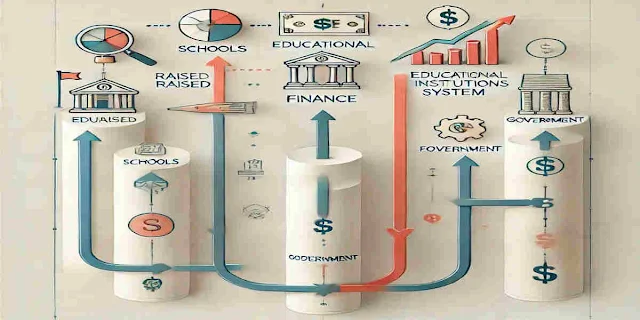Summary:
Educational financing refers to the process of utilizing public and private funds to enhance the quality and accessibility of education. It encompasses two main components: the Educational Finance System (EFS), which focuses on raising and distributing funds, and the management of education finance, which involves budgeting, accounting, and auditing. Key questions in educational finance include funding sources, payment methods, equity maintenance, and resource allocation.
In Pakistan, education financing is primarily managed by federal and provincial governments, along with contributions from individuals and organizations. Decision-making involves four levels: providers of financial resources, allocators of funds, spenders, and beneficiaries. Globally, countries allocate 6-10% of their GDP to education, with public and private sectors jointly contributing to educational initiatives. This dual responsibility underscores education's role as a semi-public service that impacts economic growth and social justice.
Educational Financing and its various sources:
Educational Financing:
Educational financing is broadly defined as the process of using public funds to improve the delivery and quality of public education programs and services through the distribution of financial and material resources. The general department of education financing can be divided into two parts.
(i) Educational Finance System.
(ii) Management of education finance.
i- Educational Finance System (EFS) is designed to raise public education funds and distribute them, while;
ii- Educational finance management is often considered to be the management of school affairs, which starts with the allocation of funds to the school district. Additionally, it includes activities like budgeting, accounting and auditing.
Each country has its own financial system, which is shaped by the country's ability to allocate money to the financial needs of education, and by socio-political pressures.
1- Introduction:
Education finance deals with such questions which are summarized below.
1- Who will pay for education?
2- Who will get the benefit from education?
3. From what sources will the amount be paid?
4- What will be the method of payment?
5- How can equity and better performance standards be maintained in terms of payment for education?
6- How should financial management be done for students?
7- How much of the total resources of the economy should be allocated for education?
8- How much of the expenses have been met from the government budget and how much will have to be paid from other sources?
9- How will the expenditure be distributed with respect to the various sub-sectors of education?
10- How should the costs be distributed with respect to different levels of education?
11- What are the alternative strategies of paying for education?
These are the fundamental questions for education finance.
2- Who Pays for Education?
Two types of questions are most important in research on education financing. The first question is who will pay for the educational expenses? While the second question is related to alternative sources of finance. In order to allocate a significant portion for education, it is necessary to make full use of the national resources. Then the financial burden should be distributed equally among individuals.
Paying for education costs is about facts and figures, which can be answered with great precision, thus yielding a substantial portion of financial statistics. However, the questions regarding the possibility of seeking or getting new financial resources in the future are mostly based on possibilities, for this a conclusion is reached by keeping in front of the alternative ways of obtaining funds politically and socially. Moreover, in this regard, the impact of different financial systems on the quality of educational institutions is also taken into consideration.
3- Institutions or Individuals:
In Pakistan, federal or provincial governments generally manage education finance, while in addition to this, various individuals, industrialists, and religious organizations in the country also organize education with personal resources. They become a source of contribution directly to education finance or in terms of taxes etc. Therefore, it is important to evaluate education finance at different levels of income and expenditure.
4- Levels of Decision-Makers in the Financing of Education:
Broadly speaking, there are four levels for decision makers in education finance.
i- Providers of these financial resources including households, businesses and donations etc.
ii- Allocators of financial resources i.e. federal and provincial governments, foundations and trusts etc.
iii- The persons or institutions spending the funds, such as district education officers, directors of education, administrators of private institutions of education, etc. They also play a role for the increase in these resources.
iv- Beneficiaries of funds include all educational institutions and all institutions supporting the promotion of education.
5- Importance of Educational Financing:
In almost all the countries of the world, education is organized in both private and public sectors. Education is not the responsibility of the government only , education at the government level is for students who cannot afford to pay the fees of educational institutions. Every country spends a significant amount of national resources on education, ranging from 6 to 10 percent of the gross national product. In some countries to increase the economic growth minimum share of measure is set. Equal distribution of educational opportunities among different groups is an important requirement of social justice.
Since the initiatives taken in the education sector play an important role in improving the economy of the country and it also has a significant impact on the distribution of wealth and sources of income, the issue of education finance becomes even more complex. Behind its complexity is the fact that education is organized in both public and private sectors. Therefore, it would be better if we call the provision of education as a semi-public service.












.jpg)
0 Comments